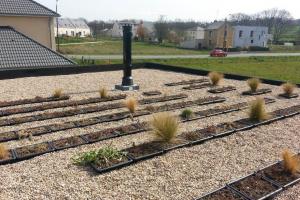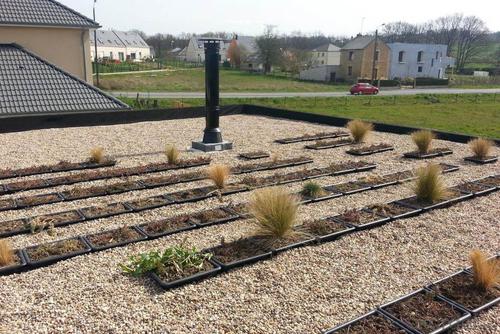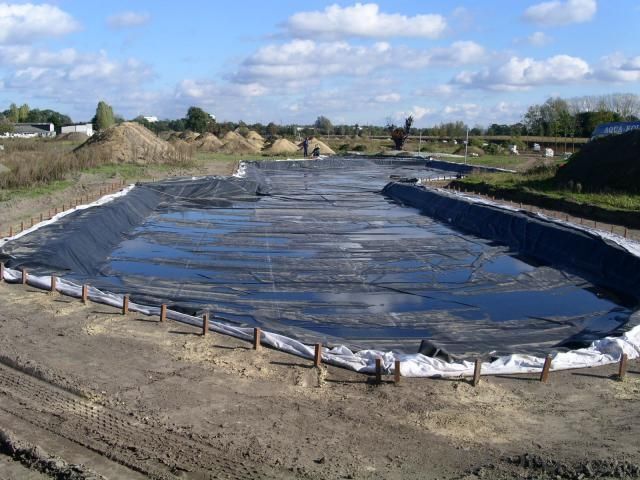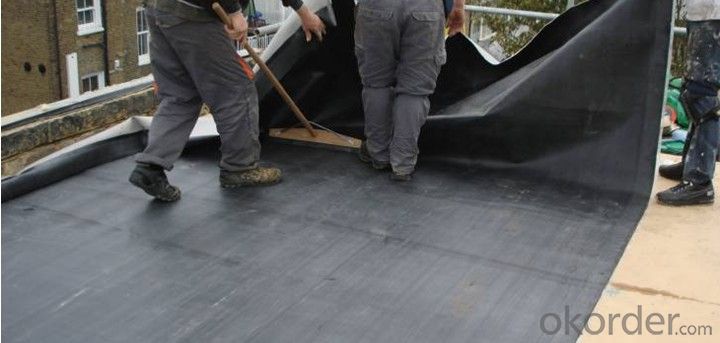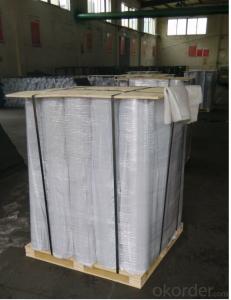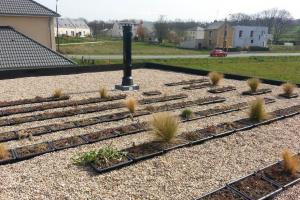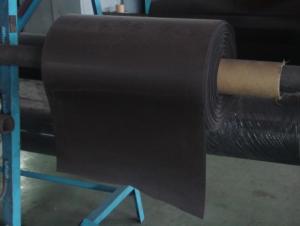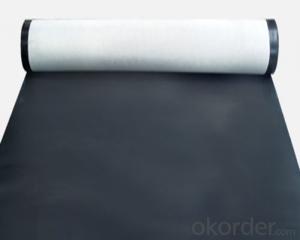EPDM Rubber Waterproof Membrane for Agriculture
- Loading Port:
- Shanghai
- Payment Terms:
- TT OR LC
- Min Order Qty:
- 50000 m²
- Supply Capability:
- 5000000 m²/month
OKorder Service Pledge
OKorder Financial Service
You Might Also Like
EPDM Rubber Waterproof Membrane for Agriculture
Description Of EPDM Rubber Waterproof Membrane for Agriculture:
This waterproof coiled material is of high elasticity with best performance among high polumer waterproof coiled material in the world.It is also the most typical one in the world.Waterproof coiled material made of ternary ethylene-propylene rubber is produced with the use of the most advanced contiuous extrusion and vulcanization technology and related equipments which are specially designed for production of such product.It is good in compactness,without bubble and performance difference in length and breadth,perfomances reach or exceed the demands of GB18173.1-2000 standard.
Main Features of EPDM Rubber Waterproof Membrane for Agriculture:
1.EPDM waterproof membrane for bridge engineering waterproof
2.EPDM waterproof membrane for water conservancy projects ,such as river bank,lake dam seepage.
3.EPDM waterproof membrane for the municipal engineering.
4.EPDM waterproof membrane for aquaculture.
Specifications of EPDM Rubber Waterproof Membrane for Agriculture:
| Number | Item | Unit | Value | |
| 1 | Size Variation | Thichness | % | ±10 |
| Width | % | ±1 | ||
| Length | % | Allowed negative | ||
| 2 | Breaking tensile strength at normal temperature | Mpa | ≥7.5 | |
| Breaking tensile strength at 70°C | Mpa | ≥2.3 | ||
| 3 | Breaking elongation at normal temperature | % | ≥450 | |
| Breaking elongation at -20°C | % | ≥200 | ||
| 4 | Tear strength | KN/m | ≥25 | |
| 5 | Impermeability(30min) | * | 0.3Mpa no leakage | |
| 6 | Bending at low tempreture | °C | ≤-40 | |
| 7 | Stretch tensor at heating | Elongate | mm | ≤2 |
| Shrink | mm | ≤4 | ||
| 8 | Air oven aging(80°C×168h) | Tensile strength at break retained | % | ≥80 |
| Elongation at break retained | % | ≥70 | ||
| 9 | Anti-alkali | Tensile strength at break retained | % | ≥80 |
| Elongation at break retained | % | ≥80 | ||
| 10 | Nuture weathing at manual simulation | Tensile strength at break retained | % | ≥80 |
| Elongation at break retained | % | ≥70 | ||
Applications of EPDM Rubber Waterproof Membrane for Agriculture:
Widely used in roofs, basement, toilet ,swimming pool, and all kinds of industry and civil building waterproofing, reservoir, vivicism, bridge, underground, tunnel and dam waterproofing ,especially to the keystone waterproofing projects which is durability, high corrosion resistance and easy deformation.



IMages of EPDM Rubber Waterproof Membrane for Agriculture:




FAQ of EPDM Rubber Waterproof Membrane for Agriculture:
1. What are we supplying?
We are specialized in producing Colorful Asphalt Roof Shingle, SBS/APP modified bitumen waterproof membrane, Self adhesive bitumen waterproof membrane, PVC waterproofing membrane, EPDM rubber roofing membrane, Single Component Polyurethane Waterproof Coating, and Spray Polyurea Waterproof Coating
.
2. How Many years experience do we have?
We have been exported to more than 20 countries in the past 15 years.
3. How long do we usually reply your request?
We always reply our customer within 24 hours.
- Q: Can a waterproofing membrane be walked on?
- Walking on a waterproofing membrane is possible, but it depends on the type of membrane and its intended use. Some waterproofing membranes, like those used in roofing, are designed to withstand foot traffic without damage. These membranes are durable and can be walked on during installation and maintenance. However, it is crucial to follow the manufacturer's guidelines to ensure the membrane remains intact and provides effective waterproofing. On the other hand, certain types of below-grade waterproofing membranes may not be suitable for walking on as it could compromise their performance. It is advisable to consult a professional or refer to the manufacturer's instructions to determine if walking on a specific waterproofing membrane is safe and appropriate.
- Q: Are waterproofing membranes resistant to oil and fuel spills?
- Waterproofing membranes are generally resistant to oil and fuel spills. These membranes are designed to create a barrier that prevents any liquid, including oil and fuel, from penetrating through them. They are typically made from materials like polyurethane or PVC, which have excellent resistance to various chemicals, including oil and fuel. This makes them suitable for applications in areas where there may be oil or fuel spills, such as parking garages, industrial facilities, or areas with vehicles. However, it's important to note that the level of resistance can vary depending on the specific type and quality of the membrane used. Therefore, it is crucial to select a high-quality and appropriate waterproofing membrane that meets the project's specific requirements to ensure long-term resistance to oil and fuel spills.
- Q: Can waterproofing membranes be used on concrete manholes?
- Indeed, concrete manholes can benefit from the application of waterproofing membranes. These membranes are widely utilized to safeguard structures against water penetration and can be effectively utilized on various surfaces, including concrete. Given that concrete manholes are susceptible to water ingress, which may result in deterioration and structural problems over time, the application of a waterproofing membrane on the concrete surface of the manhole creates a barrier that prevents water intrusion into the structure. This measure serves to lengthen the lifespan of the manhole and guarantee its structural integrity in the long run. Moreover, in addition to providing protection against chemical attacks and other environmental factors, waterproofing membranes further enhance the durability of concrete manholes.
- Q: Are there any specific considerations for installing a waterproofing membrane on wood surfaces?
- Yes, there are several specific considerations when installing a waterproofing membrane on wood surfaces. First and foremost, it is important to ensure that the wood surface is clean, dry, and free from any dirt, dust, or debris. This will help to create a proper bond between the wood and the waterproofing membrane. Additionally, it is crucial to choose a waterproofing membrane that is specifically designed for wood surfaces. There are different types of membranes available, such as liquid-applied membranes or sheet membranes, so selecting the right one is essential. Before applying the membrane, it is advisable to prime the wood surface with a suitable primer. This will help to enhance the adhesion of the membrane and provide a more durable and long-lasting waterproofing solution. It is also important to consider the climate and weather conditions in the area where the wood surface is located. If the area is prone to extreme temperatures or heavy rainfall, it is recommended to choose a waterproofing membrane that can withstand these conditions and provide adequate protection. Furthermore, proper installation techniques should be followed to ensure the membrane is applied correctly. This may involve rolling or brushing the membrane onto the wood surface, as per the manufacturer's instructions. It is crucial to pay attention to details such as seams, corners, and edges to ensure a watertight seal. Regular maintenance and inspection are essential for the longevity of the waterproofing membrane on wood surfaces. It is important to check for any signs of damage, such as cracks or peeling, and address them promptly to prevent water infiltration and potential damage to the wood. In summary, when installing a waterproofing membrane on wood surfaces, it is crucial to prepare the surface properly, choose the right type of membrane, consider the climate and weather conditions, follow proper installation techniques, and perform regular maintenance and inspection. By doing so, you can effectively protect the wood surface from water damage and ensure its longevity.
- Q: Can waterproofing membranes be installed on uneven surfaces?
- Yes, waterproofing membranes can be installed on uneven surfaces. However, to ensure effective installation, it is important to properly prepare the surface by leveling or smoothing it out as much as possible before applying the membrane.
- Q: What is the typical installation process for a waterproofing membrane?
- Installing a waterproofing membrane typically involves several steps. Firstly, the surface requiring waterproofing is thoroughly cleaned and prepared by eliminating any existing coatings, debris, or loose materials. It is essential to guarantee that the surface is smooth, clean, and devoid of any contaminants that may hinder the membrane's adhesion. Secondly, any cracks, holes, or imperfections in the surface are repaired. This entails filling cracks with a suitable filler or patching compound and smoothing out rough areas. It is crucial to have a solid and even surface to ensure proper installation and efficacy of the waterproofing membrane. Once the surface is prepared, it is often necessary to apply a primer to enhance adhesion between the surface and the membrane. The primer is typically applied using a brush or roller, following the manufacturer's instructions. After the primer has dried, the waterproofing membrane is mounted. There are various types of membranes available, such as sheet membranes or liquid-applied membranes. Sheet membranes are usually rolled out onto the surface and adhered using an appropriate adhesive or mortar. Liquid-applied membranes are applied using a brush, roller, or spray equipment to create a continuous and seamless barrier. Throughout the installation process, it is crucial to ensure correct membrane installation with proper overlap or seams. Additionally, any penetrations or transitions must be adequately treated and sealed. This includes areas such as corners, edges, drains, and pipe penetrations, where additional detailing may be necessary to create a watertight seal. Once the membrane is installed, it is important to allow it to cure or dry according to the manufacturer's instructions. This ensures that the membrane reaches its maximum strength and waterproofing capabilities. Finally, after the membrane has cured, it may be beneficial to apply a protective layer or coating to enhance the durability and longevity of the waterproofing system. This may involve applying a topcoat, sealant, or protective barrier to shield the membrane from UV rays, foot traffic, or other potential sources of damage. In summary, the installation process for a waterproofing membrane includes surface preparation, primer application, membrane installation, detailing and sealing, curing, and potentially applying a protective layer. It is crucial to adhere to the manufacturer's instructions and consult with a professional if necessary to ensure proper and effective installation.
- Q: Can a waterproofing membrane be used on concrete walls?
- Yes, a waterproofing membrane can be used on concrete walls. Waterproofing membranes are designed to provide a protective barrier against water penetration, and they can be applied to various surfaces including concrete walls. These membranes are typically made of materials such as modified bitumen, rubberized asphalt, or synthetic polymers, which are highly resistant to water and moisture. Applying a waterproofing membrane on concrete walls can effectively prevent water seepage, dampness, and potential damage caused by water infiltration. The membrane acts as a barrier, preventing water from permeating through the concrete and reaching the interior spaces. It also helps to maintain the structural integrity of the concrete by minimizing the risks of cracks, efflorescence, and other forms of moisture-related deterioration. There are different types of waterproofing membranes available in the market, such as sheet membranes, liquid membranes, and cementitious coatings. The choice of the membrane depends on factors such as the specific application, the degree of water exposure, and the condition of the concrete wall. It is essential to select a membrane that is compatible with the concrete and provides long-lasting waterproofing protection. Before applying the membrane, it is crucial to prepare the concrete surface properly. This may involve cleaning, repairing any cracks or imperfections, and ensuring that the surface is dry and free from any contaminants. The membrane is then installed according to the manufacturer's instructions, typically by adhering it to the concrete or by applying a liquid membrane using a brush or roller. In conclusion, a waterproofing membrane can be used on concrete walls to effectively protect them from water infiltration. This can help to maintain the durability and longevity of the concrete, as well as prevent potential water damage to the interior spaces. However, it is essential to choose the right type of membrane and follow proper installation procedures for optimal results.
- Q: Are waterproofing membranes suitable for indoor applications?
- Yes, waterproofing membranes are suitable for indoor applications. Waterproofing membranes are designed to prevent water penetration and moisture buildup, making them an ideal solution for areas that are prone to water damage, such as basements, bathrooms, and kitchens. These membranes create a barrier that prevents water from seeping through floors, walls, or other surfaces, effectively protecting the structure from water-related issues like mold, rot, and structural damage. Additionally, waterproofing membranes can also help regulate humidity levels, leading to a more comfortable and healthier indoor environment.
- Q: Can a waterproofing membrane reduce noise transmission?
- Yes, a waterproofing membrane can help reduce noise transmission. Waterproofing membranes are typically made of materials with good sound insulation properties, such as rubber or synthetic polymers. When applied to surfaces, they create a barrier that helps absorb or block sound waves, reducing the amount of noise that can pass through the structure. Additionally, waterproofing membranes can also help seal gaps and cracks in walls or floors, further reducing noise leakage. So, while the primary function of a waterproofing membrane is to prevent water infiltration, it can also have the secondary benefit of reducing noise transmission.
- Q: Can a waterproofing membrane be used for train platforms?
- Train platforms can indeed benefit from the application of a waterproofing membrane. Given their exposure to different weather conditions like rain and snow, it is important to address potential water damage and deterioration over time. One effective method is to install a waterproofing membrane on the surface of the platform. This protective barrier prevents water from seeping through and causing harm to the underlying structure. Consequently, this approach not only prolongs the platform's lifespan but also reduces maintenance costs and ensures the safety of passengers and personnel. In addition, the use of a waterproofing membrane can help prevent the growth of mold and mildew, which can negatively impact the health of those using the train platform. All in all, utilizing a waterproofing membrane on train platforms proves to be a practical and efficient solution for safeguarding against water damage and maintaining the infrastructure's longevity.
Send your message to us
EPDM Rubber Waterproof Membrane for Agriculture
- Loading Port:
- Shanghai
- Payment Terms:
- TT OR LC
- Min Order Qty:
- 50000 m²
- Supply Capability:
- 5000000 m²/month
OKorder Service Pledge
OKorder Financial Service
Similar products
Hot products
Hot Searches
Related keywords
